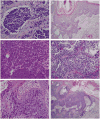Merkel Cell Carcinoma
- PMID: 28477888
- PMCID: PMC5443625
- DOI: 10.1016/j.path.2017.01.013
Merkel Cell Carcinoma
Abstract
Merkel cell carcinoma (MCC) encompasses neuroendocrine carcinomas primary to skin and occurs most commonly in association with clonally integrated Merkel cell polyomavirus with related retinoblastoma protein sequestration or in association with UV radiation-induced alterations involving the TP53 gene and mutations, heterozygous deletion, and hypermethylation of the Retinoblastoma gene. Molecular genetic signatures may provide therapeutic guidance. Morphologic features, although patterned, are associated with predictable diagnostic pitfalls, usually resolvable by immunohistochemistry. Therapeutic options for MCC, traditionally limited to surgical intervention and later chemotherapy and radiation, are growing, given promising early results of immunotherapeutic regimens.
Keywords: Merkel cell; Neuroendocrine; Polyomavirus; UV.
Copyright © 2017 Elsevier Inc. All rights reserved.
Figures




References
-
- Bichakjian CK, Lowe L, Lao CD, et al. Merkel cell carcinoma: critical review with guidelines for multi-disciplinary management. Cancer. 2007;110:1–12. - PubMed
-
- Agelli M, Clegg LX. Epidemiology of primary Merkel cell carcinoma in the United States. J Am Acad Dermatol. 2003;49:832–41. - PubMed
-
- Sihto H, Kukko H, Koljonen V, et al. Merkel cell polyomavirus infection, large T antigen, retinoblastoma protein and outcome in Merkel cell carcinoma. Clin Cancer Res. 2011;17:4806–13. - PubMed
-
- Bichakjian CK, Hghiem P, Johnson T, et al. Merkel cell carcinoma. New York: Springer; 2016.
Publication types
MeSH terms
Substances
Grants and funding
LinkOut - more resources
Full Text Sources
Other Literature Sources
Medical
Research Materials
Miscellaneous

